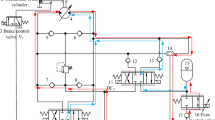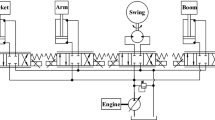Abstract
A novel energy regeneration swing system is proposed for hydraulic excavator in this paper to reduce the energy consumption. Two independent accumulators are proposed for use in the hybrid swing system. The combined control of hydraulic motor displacement and flow control valve and a variable accumulator control strategy were proposed to improve the energy regeneration efficiency and ensure the system performance. A testbench was set up, and experiments were conducted. The experiment verified that the energy regeneration efficiency of the proposed system ranged from 23 to 56% in different conditions.














Similar content being viewed by others
Abbreviations
- J :
-
Moment of inertia of the flywheel
- ω :
-
The speed of the flywheel
- T f :
-
Coulomb friction torque
- T w :
-
Torque of wind resistance
- T dec :
-
Deceleration torque of the hydraulic motor
- p ho :
-
Pressure of the output side of the hydraulic motor
- D :
-
Displacement of the hydraulic motor
- η m :
-
Torque efficiency of the hydraulic motor
- Q a :
-
Flow rate through FCV
- p a :
-
Pressure of the output port of the orifice
- A :
-
Orifice area of the valve
- C d :
-
Flow coefficient
- ρ :
-
Density of the hydraulic oil
- V1:
-
The volume of the chamber
- βe:
-
The effective bulk modulus of the hydraulic oil
- Qh:
-
The flow form the hydraulic motor
- u m :
-
Control signal of the hydraulic motor displacement
- u v :
-
Control signal of the FCV
- D max :
-
The maximum hydraulic motor displacement
- Dr:
-
Reference hydraulic motor displacement
- α :
-
Displacement ratio
- α r :
-
Reference displacement ratio
- ω :
-
Speed of the flywheel
- E reg :
-
Regenerated energy
- Q acc :
-
Flow rate and of accumulator
- p acc :
-
Pressure of accumulator
- p g :
-
Pressure of the gas in accumulator
- V g :
-
Volume of the gas in accumulator
- n:
-
Adiabatic exponent
- E FW :
-
Kinetic energy of the flywheel
- η reg :
-
Energy regeneration efficiency
References
Lee, H. S., Kim, J. S., Park, Y. I., & Cha, S. W. (2016). Rule-based power distribution in the power train of a parallel hybrid tractor for fuel savings. International Journal of Precision Engineering and Manufacturing Green Technology,3(3), 231–237.
Lee, H., Jeong, J., Park, Y. I., & Cha, S. W. (2017). Energy management strategy of hybrid electric electric vehicle using battery state of charge trajectory information. International Journal of Precision Engineering and Manufacturing Green Technology,4(1), 79–86.
Yu, Y. X., Jeong, E. J., & Ahn, K. K. “Research on Energy Regeneration of a Hydraulic Excavator Boom System, 2018 Spring Conference on Drive and Control, pp. 71–76, 2018.
Ahn, K. K., Truong, D. Q., Tien, H. H., & Yoon, J. L. (2012). An innovative design of wave energy converter. Renewable Energy,42, 186–194.
Truong, D. Q., & Ahn, K. K. (2012). Wave prediction based on a modified grey model MGM (1, 1) for real-time control of wave energy converters in irregular waves. Renewable Energy,43, 242–255.
Truong, D. Q., Ahn, K. K., Soo, K. J., & Soo, Y. H. Application of fuzzy-PID controller in hydraulic load simulator, 2007 International Conference on Mechatronics and Automation, Vol.43, pp.3338-3343, 2007.
Truong, D. Q., & Ahn, K. K. (2011). Parallel control for electro-hydraulic load simulator using online self tuning fuzzy PID technique. Asian Journal of Control,13(4), 522–541.
Ge, L., Quan, L., Zhang, X., Zhao, B., & Yang, J. (2017). Efficiency improvement and evaluation of electric hydraulic excavator with speed and displacement variable pump. Energy Conversion and Management,150, 62–71.
Xia, L., Quan, L., Ge, L., & Hao, Y. (2018). Energy efficiency analysis of integrated drive and energy recuperation system for hydraulic excavator boom. Energy Conversion and Management,156, 680–687.
Yu, Y. X., Das, D., Truong. B. N. M, & Ahn. K. K. A study on the energy regeneration system of boom for hybrid hydraulic excavator in 2015 15th International Conference on Control, Automation and Systems (ICCAS), pp. 1910–1914,2015.
Sun, H., Yang, L., Jing, J., & Luo, Y. (2011). Control strategy of hydraulic/electric synergy system in heavy hybrid vehicles. Energy Conversion and Management,52(1), 668–674.
Wang, D., & Zhang, Y. (2014). Research on the energy recovery of the excavator slewing system based on hybrid technology (pp. 986–987). Switzerland: Trans Tech Publications.
Amirante, R., Cassone, E., Distaso, E., & Tamburrano, P. (2017). Overview on recent developments in energy storage: mechanical, electrochemical and hydrogen technologies. Energy Conversion and Management,132, 372–387.
Shen, W., Jiang, J., Su, X., & Hamid, R. K. (2014). Control strategy analysis of the hydraulic hybrid excavator. Journal of the Franklin Institute,352(2), 541–561.
Lin, T., Huang, W., Ren, H., Fu, S., & Liu, Q. (2016). New compound energy regeneration system and control strategy for hybrid hydraulic excavators. Automation in Construction,68, 11–20.
Sun, H., & Jing, J. (2010). Research on the system configuration and energy control strategy for parallel hydraulic hybrid loader. Automation in Construction,19(2), 213–220.
Chen, M., & Zhao, D. (2017). The gravitational potential energy regeneration system with closed-circuit of boom of hydraulic excavator. Mechanical Systems and Signal Processing,82, 178–192.
Chowdhury, P., Das, D., Truong, B. N. M., & Ahn, K. K., “Research on energy regeneration and effect of dynamic characteristics of secondary control swing for hydraulic excavator system,” in 2015 15th International Conference on Control, Automation and Systems (ICCAS), pp. 1936–1940, 2015.
Wang, T., & Wang, Q. (2014). Efficiency analysis and evaluation of energy-saving pressure-compensated circuit for hybrid hydraulic excavator. Automation in Construction,47, 62–68.
Minav, T. A., Virtanen, A., Laurila, L., & Pyrhönen, J. (2012). Storage of energy recovered from an industrial forklift. Automation in Construction,22, 506–515.
Lin, T., Wang, Q., Hu, B., & Gong, W. (2010). Research on the energy regeneration systems for hybrid hydraulic excavators. Automation in Construction,19(8), 1016–1026.
Pettersson, K., “Secondary control in construction machinery: Design and evaluation of an excavator swing drive,” in 11th Scandinavian International Conference on Fluid Power, 2009.
Thompson, B., Yoon, H. S., Kim, J., & Lee, J. Swing Energy Recuperation Scheme for Hydraulic Excavators, SAE 2014 Commercial Vehicle Engineering Congress, Vol. 2014. 2014.
Yu, Y. X., & Ahn, K. K., “Study on energy regeneration of hybrid hydraulic excavator using hydraulic transformer,” in 2016 16th International Conference on Control, Automation and Systems (ICCAS), pp. 173–177, 2016.
Truong, B. N. M., Truong, D. Q., Lee, S. Y., Ahn, K. K., & Truong, Q. T., “Study on energy regeneration system for hybrid hydraulic excavator,” in 2015 International Conference on Fluid Power and Mechatronics (FPM), 2015, pp. 1349–1354.
Yu, Y. X., & Ahn, K. K. (2017). Application of hydraulic transformer on energy saving for boom system of hybrid hydraulic excavator. Applied Mechanics and Materials,868, 118–123.
Zang, F., “Assembly simulation research for hydraulic transformer with virtual manufacturing technology,” in International Technology and Innovation Conference 2009 (ITIC 2009), pp. 1–6, 2009.
Yu, Y. X., & Ahn, K. K., “Study on novel structure and control of energy saving of hydraulic hybrid excavator,” in 2017 17th International Conference on Control, Automation and Systems (ICCAS), pp. 1127–1131,2017.
Gong, J., Zhang, D., Guo, Y., Liu, C., Zhao, Y., Hu, P., et al. (2019). Power control strategy and performance evaluation of a novel electro-hydraulic energy-saving system. Applied Energy,233–234(1), 724–734.
Shen, W., Jiang, J., Su, X., & Karimi, H. R. (2015). Control strategy analysis of the hydraulic hybrid excavator. Journal of the Franklin Institute,352(2), 541–561.
Chen, Q., Lin, T., Ren, H., & Fu, S. (2019). Novel potential energy regeneration systems for hybrid hydraulic excavators. Mathematics and Computers in Simulation,163, 130–146.
Yu, Y. X., & Ahn, K. K. (2019). Optimization of energy regeneration of hybrid hydraulic excavator boom system. Energy Conversion and Management,183(1), 26–34.
Kim, N., Jeong, J., & Zheng, C. (2019). Adaptive energy management strategy for plug-in hybrid electric vehicles with pontryagin’s minimum principle based on daily driving patterns. International Journal of Precision Engineering and Manufacturing Green Technology,6, 539–548.
Huang, H., Zou, X., Li, L., et al. (2019). Energy-saving design method for hydraulic press drive system with multi motor-pumps. International Journal of Precision Engineering and Manufacturing Green Technology,6(2), 223–234.
Zhao, P. Y., Chen, Y. L., & Zhou, H. (2017). Simulation analysis of potential energy recovery system of hydraulic hybrid excavator. International Journal of Precision Engineering and Manufacturing,18(11), 1575–1589.
Jeong, J. B., & Kim, K. S. (2018). A study on driving algorithm and communication characteristics for remote control of mini excavator. Journal of Drive and Control,15(4), 81–90.
Yu, Y. X., Jeong, E. J., & Ahn, K. K. (2018). Review of energy saving technology of hybrid construction machine. Journal of Drive and Control,15(4), 91–100.
Ho, T. H., & Ahn, K. K. (2010). Modeling and simulation of hydrostatic transmission system with energy regeneration using hydraulic accumulator. Journal of Mechanical Science and Technology,24(5), 1163–1275.
Ho, T. H., & Ahn, K. K. (2012). Design and control of a closed-loop hydraulic energy-regenerative system. Automation in Construction,22, 444–458.
Acknowledgements
This work was supported by Basic Science Research Program through the National Research Foundation of Korea (NRF-2017R1A2B3004625) and supported by the Korea Institute of Energy Technology Evaluation and Planning (KETEP) grant funded by the Korea Government Ministry of Trade, Industry and Energy. (G032070311).
Author information
Authors and Affiliations
Corresponding author
Additional information
Publisher's Note
Springer Nature remains neutral with regard to jurisdictional claims in published maps and institutional affiliations.
Rights and permissions
About this article
Cite this article
Yu, YX., Ahn, K.K. Improvement of Energy Regeneration for Hydraulic Excavator Swing System. Int. J. of Precis. Eng. and Manuf.-Green Tech. 7, 53–67 (2020). https://doi.org/10.1007/s40684-019-00165-7
Received:
Revised:
Accepted:
Published:
Issue Date:
DOI: https://doi.org/10.1007/s40684-019-00165-7




